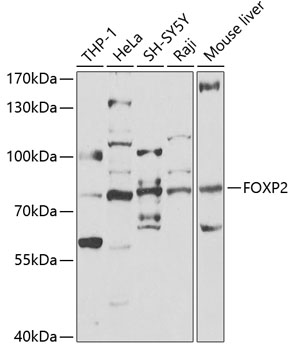Anti-FOXP2 Antibody (CAB5677)
- SKU:
- CAB5677
- Product type:
- Antibody
- Reactivity:
- Human
- Mouse
- Rat
- Host Species:
- Rabbit
- Isotype:
- IgG
- Antibody Type:
- Polyclonal Antibody
- Research Area:
- Epigenetics and Nuclear Signaling
Description
| Antibody Name: | Anti-FOXP2 Antibody |
| Antibody SKU: | CAB5677 |
| Antibody Size: | 20uL, 50uL, 100uL |
| Application: | WB |
| Reactivity: | Human, Mouse, Rat |
| Host Species: | Rabbit |
| Immunogen: | Recombinant fusion protein containing a sequence corresponding to amino acids 441-740 of human FOXP2 (NP_683696.2). |
| Application: | WB |
| Recommended Dilution: | WB 1:500 - 1:2000 |
| Reactivity: | Human, Mouse, Rat |
| Positive Samples: | THP-1, HeLa, SH-SY5Y, Raji, Mouse liver |
| Immunogen: | Recombinant fusion protein containing a sequence corresponding to amino acids 441-740 of human FOXP2 (NP_683696.2). |
| Purification Method: | Affinity purification |
| Storage Buffer: | Store at -20°C. Avoid freeze / thaw cycles. Buffer: PBS with 0.02% sodium azide, 50% glycerol, pH7.3. |
| Isotype: | IgG |
| Sequence: | PKPS PKPL NLVS SVTM SKNM LETS PQSL PQTP TTPT APVT PITQ GPSV ITPA SVPN VGAI RRRH SDKY NIPM SSEI APNY EFYK NADV RPPF TYAT LIRQ AIME SSDR QLTL NEIY SWFT RTFA YFRR NAAT WKNA VRHN LSLH KCFV RVEN VKGA VWTV DEVE YQKR RSQK ITGS PTLV KNIP TSLG YGAA LNAS LQAA LAES SLPL LSNP GLIN NASS GLLQ AVHE DLNG SLDH IDSN GNSS PGCS PQPH IHSI HVKE EPVI AEDE DCPM SLVT TANH SPEL EDDR EIEE EPLS EDLE |
| Gene ID: | 93986 |
| Uniprot: | O15409 |
| Cellular Location: | Nucleus |
| Calculated MW: | 9-18kDa/40- 48kDa/70- 82kDa |
| Observed MW: | 80kDa |
| Synonyms: | FOXP2, CAGH44, SPCH1, TNRC10 |
| Background: | This gene encodes a member of the forkhead/winged-helix (FOX) family of transcription factors. It is expressed in fetal and adult brain as well as in several other organs such as the lung and gut. The protein product contains a FOX DNA-binding domain and a large polyglutamine tract and is an evolutionarily conserved transcription factor, which may bind directly to approximately 300 to 400 gene promoters in the human genome to regulate the expression of a variety of genes. This gene is required for proper development of speech and language regions of the brain during embryogenesis, and may be involved in a variety of biological pathways and cascades that may ultimately influence language development. Mutations in this gene cause speech-language disorder 1 (SPCH1), also known as autosomal dominant speech and language disorder with orofacial dyspraxia. Multiple alternative transcripts encoding different isoforms have been identified in this gene. |
| UniProt Protein Function: | FOXP2: Transcriptional repressor that may play a role in the specification and differentiation of lung epithelium. May also play a role in developing neural, gastrointestinal and cardiovascular tissues. Can act with CTBP1 to synergistically repress transcription but CTPBP1 is not essential. Involved in neural mechanisms mediating the development of speech and language. Forms homodimers and heterodimers with FOXP1 and FOXP4. Dimerization is required for DNA-binding. Interacts with CTBP1. Isoform 1 and isoform 6 are expressed in adult and fetal brain, caudate nucleus and lung. 9 isoforms of the human protein are produced by alternative splicing. |
| UniProt Protein Details: | Protein type:C2H2-type zinc finger protein; DNA-binding Chromosomal Location of Human Ortholog: 7q31 Cellular Component: nucleus Molecular Function:protein binding; protein homodimerization activity; DNA binding; sequence-specific DNA binding; protein heterodimerization activity; metal ion binding; transcription factor activity Biological Process: skeletal muscle development; caudate nucleus development; camera-type eye development; transcription, DNA-dependent; righting reflex; putamen development; negative regulation of transcription from RNA polymerase II promoter; vocal learning; post-embryonic development; smooth muscle development; positive regulation of mesenchymal cell proliferation; cerebellum development; cerebral cortex development; negative regulation of transcription, DNA-dependent; alveolus development; growth Disease: Speech-language Disorder 1 |
| NCBI Summary: | This gene encodes a member of the forkhead/winged-helix (FOX) family of transcription factors. It is expressed in fetal and adult brain as well as in several other organs such as the lung and gut. The protein product contains a FOX DNA-binding domain and a large polyglutamine tract and is an evolutionarily conserved transcription factor, which may bind directly to approximately 300 to 400 gene promoters in the human genome to regulate the expression of a variety of genes. This gene is required for proper development of speech and language regions of the brain during embryogenesis, and may be involved in a variety of biological pathways and cascades that may ultimately influence language development. Mutations in this gene cause speech-language disorder 1 (SPCH1), also known as autosomal dominant speech and language disorder with orofacial dyspraxia. Multiple alternative transcripts encoding different isoforms have been identified in this gene.[provided by RefSeq, Feb 2010] |
| UniProt Code: | O15409 |
| NCBI GenInfo Identifier: | 17432967 |
| NCBI Gene ID: | 93986 |
| NCBI Accession: | O15409.2 |
| UniProt Secondary Accession: | O15409,Q6ZND1, Q75MJ3, Q8IZE0, Q8N0W2, Q8N6B7, Q8N6B8 Q8NFQ1, A0AUV6, A4D0U8, A6NNW4, B4DLD9, |
| UniProt Related Accession: | O15409 |
| Molecular Weight: | 715 |
| NCBI Full Name: | Forkhead box protein P2 |
| NCBI Synonym Full Names: | forkhead box P2 |
| NCBI Official Symbol: | FOXP2 |
| NCBI Official Synonym Symbols: | SPCH1; CAGH44; TNRC10 |
| NCBI Protein Information: | forkhead box protein P2; CAG repeat protein 44; trinucleotide repeat containing 10; forkhead/winged-helix transcription factor; trinucleotide repeat-containing gene 10 protein |
| UniProt Protein Name: | Forkhead box protein P2 |
| UniProt Synonym Protein Names: | CAG repeat protein 44; Trinucleotide repeat-containing gene 10 protein |
| Protein Family: | Forkhead box protein |
| UniProt Gene Name: | FOXP2 |
| UniProt Entry Name: | FOXP2_HUMAN |







